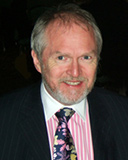Peter C. Neligan received his medical education at the University of Dublin, Trinity College, graduating MB, BCh, BAO in 1975. He obtained his FRCS in general surgery from the Royal College of Surgeons in Ireland in 1980 and subsequently trained in Plastic Surgery in Dublin. In 1983 he moved to Toronto for fellowship training at the University of Toronto, completing fellowships in surgical research, pediatric plastic surgery, microvascular surgery, and burn surgery.
Having obtained his FRCSC in Plastic Surgery, Dr. Neligan established practice in Sudbury, Ontario in 1987 before returning to the University of Toronto in 1991 to take up a position at the Wellesley Hospital as Director of the Ross Tilley Burn Unit.
In 1993 he moved to Toronto General Hospital where he specialized in oncologic reconstruction and reconstructive microsurgery. Dr. Neligan served as Chief of Plastic Surgery at TGH from 1996 until 2007. In 1996 he was appointed Chair of the University Division of Plastic Surgery. In 1999 he was appointed the Wharton Chair in Reconstructive Plastic Surgery, the first endowed chair in Plastic Surgery in Canada. Dr. Neligan moved to Seattle, WA in July 2007 where he is now a Professor at the University of Washington in the Departments of Surgery and Otolaryngology/Head & Neck Surgery. He is active in numerous societies, and is past president of the Plastic Surgery Foundation, The American Society for Reconstructive Microsurgery and the North American Skull Base Society. Dr. Neligan currently serves on the Board of Directors for the American Society of Plastic Surgeons and is a past member of the Board of Directors for the American Head and Neck Society. He is the immediate past Chair of the Advisory Council for Plastic and Maxillofacial Surgery at the American College of Surgeons.
Peter is a remarkable individual. Incredibly energetic and always maintains a smile on his face…a total “can-do” attitude and seems to not to be able to understand the word “no”. The following excerpt from an article he wrote about the identity of plastic and reconstructive surgery and highlights some elements of his spirit, optimistic attitude and desire to further the specialty is well worth repeating.
“A new crop of medical students will begin a residency in plastic surgery this summer. They have worked long and hard to secure these coveted spots. As a service to them and to the profession, I wanted to take this opportunity to help make their path a little easier by offering a bit of advice.
When asked what you do, simply say that you are a surgeon. I avoid saying “plastic surgeon” because it invariably prompts awkward facial expressions and comments to the effect that I am just the person they’ve been waiting to meet, nod nod, wink wink! In many people’s minds, plastic surgery is synonymous with cosmetic surgery, yet I do no cosmetic surgery. This usually strikes people as very odd. A plastic surgeon who doesn’t do cosmetic surgery is like an auto mechanic who doesn’t fix cars, or a teacher who doesn’t teach.
So what do I do? Strictly speaking I should describe myself as a reconstructive microsurgeon, although that usually draws blank stares. The truth is that while cosmetic surgery is probably the most visible and perhaps the most glamorous aspect of plastic surgery, it’s a relatively small part of the specialty. The breadth of the specialty fills the six-volume Plastic Surgery textbook I recently published with Elsevier. Only one of these volumes is dedicated to Aesthetic Surgery.
Some say that plastic surgeons are the last general surgeons. We don’t own a disease like cancer doctors do, and we don’t own a part of the body like heart surgeons do. We work all over the body on all kinds of diseases and frequently with other physicians in a multidisciplinary group. We’re not only misunderstood by the public but also by many of our medical colleagues.
Several years ago on Christmas day, I finished an emergency case in the operating room. One of my cardiac surgery colleagues had done a coronary artery bypass graft on a patient several days before. The sternotomy wound became infected, and the patient became gravely ill. As a reconstructive plastic surgeon, I was called upon to remove the infected tissue and reconstruct the patient with muscle flaps to provide healthy cover for his exposed heart.
As I was leaving the hospital, I saw an internist colleague in the lobby. He called out, “Hey Peter, what are you doing here on Christmas Day? Somebody drop their face?” My cardiac surgery colleague set him straight and told him I had just saved his patient.
On another occasion I treated a young woman who developed a cancer in the floor of her mouth. I reconstructed the defect by taking bone and soft tissue from her leg, transferring it to her face and shaping it to reconstruct the missing jaw, the floor of her mouth and tongue. I reconnected the small blood vessels that nourished this tissue to blood vessels in her neck using an operating microscope. When I spoke to her family at the end of this eight-hour case, they looked confused and asked when she would be seeing the plastic surgeon. This kind of misconception happens all the time.
The history of plastic surgery is one of innovation. Plastic surgeon Dr. Joseph Murray performed the world’s first kidney transplant in Boston in 1954. Five years later, he performed the world’s first successful allograft and, in 1962, the world’s first renal transplant on a cadaver. He received the Nobel Prize in 1990.What, you might ask, was a plastic surgeon doing transplanting kidneys? His experience treating burn patients sent back from World War II gave him wide exposure to skin grafting and raised issues of immune-rejection that he studied using the kidney as a single-organ model. In recent years, too, plastic surgeons are leading the way in hand and face transplantation, continuing Dr. Murray’s tradition of innovation.
I’m very proud to be a plastic surgeon, but it requires a lot of explaining. To my early-career colleagues, I wish you a successful and satisfying career and a dash of good humor. Chances are, you’re going to need it!”
Source: https://www.elsevier.com/connect/the-misunderstood-world-of-a-plastic-surgeon
Dr. Neligan has authored 7 books, over 70 book chapters, and over 170 peer-reviewed papers. He is the series editor of the third edition of the 6-volume set, Plastic Surgery, considered to be the bible of Plastic and Reconstructive Surgery. He has made over 200 peer-reviewed presentations at national and international meetings as well as delivering numerous invited lectures. He has served as Visiting Professor to numerous institutions nationally and internationally. He sits on the Editorial Board of five journals and is Editor-in-Chief of the Journal of Reconstructive Microsurgery.


